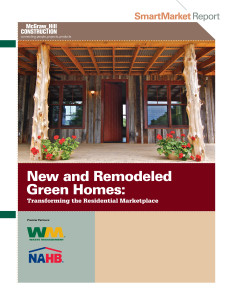One way today’s forward-looking companies are setting themselves apart from competition is targeting consumers concerned with the long term impacts of their purchasing decisions. Terms such as “organic”, “recyclable” and “sustainable” are used to describe everything from toothpaste to tires in hopes of capturing the interest of today’s green-minded buyer. Builders, remodelers, architects and others in the housing industry have taken this movement to heart. “Green” homes, which were once a small niche in the industry, are quickly moving toward mainstream.
A Smart Market Report from the National Association of Home Builders (NAHB), McGraw Hill Construction and Waste Management found that:
- Green homes’ share of the construction market jumped to 17 percent in 2011, up from just 2 percent only a decade ago. That translates to an opportunity of about $17 billion last year alone.
- The forecast for the future was even more unexpected: Green homes are expected to comprise as much as 29 percent to 38 percent of the market by 2016.
 In 2009 more than two-thirds of builders described their businesses’ involvement in green projects as “marginal” or “not-at-all involved.” For remodelers, that number exceeded 75 percent. Yet less than a quarter of these same two groups believed they will still be operating without a more significant green influence by 2016.
In 2009 more than two-thirds of builders described their businesses’ involvement in green projects as “marginal” or “not-at-all involved.” For remodelers, that number exceeded 75 percent. Yet less than a quarter of these same two groups believed they will still be operating without a more significant green influence by 2016.
Since the study queries the industry practitioners themselves about how their own businesses will respond to the green marketplace, the implications of this trend are clear: in the very near future, green building and remodeling will become much less about tapping into a niche and more about staying relevant amid a rapidly-changing competitive landscape.
Another eye opener revealed by the study is that more than 60 percent of builders and remodelers report that buyers are willing to pay a premium for a green project. This runs counter to the popular notion that customers aren’t really willing to pay more for green. Further, the more involved an industry professional is in green building; the more he or she feels that buyers are willing to pay for it.
Of course geographic, social, economic and many other factors affect the degree to which buyers will accept green premiums. But in general, practitioners that are most engaged in green seem to have figured out how to sell projects that admittedly cost more.
Fortunately for the industry, the Smart Market Report is also helpful in identifying what green features are popular among builders, and by extension, what value propositions the successful green practitioner may be employing to sell his or her projects.

Photography by Tucker English
For example, when asked to select the most important green practices, more than 95 percent selected “energy efficiency.” That nearly doubled the next most popular “durable materials.” The rest in decreasing order were: “water efficiency,” “low VOC [volatile organic compound]-emitting materials/improved indoor air quality,” “construction waste management/reduction” and “site planning and development.”
The most popular green features are those that can provide more tangible, nearer-term value directly to the buyer: lower utility bills and less maintenance. Next are those with benefits down the road such as reducing landfill waste or minimizing storm water runoff. That’s not to say these practices aren’t important, just that they might not be imperatives when pitching projects to buyers.

